From Puncheon Road
to Scenic Byway
to Scenic Byway
Our area roads and bridges were expensive to build, but they also required money to maintain. With the collapse of the housing market in 2008, resulting city and county revenue shortages were stretched, and difficult choices had to be made. In 2013, King County announced risk of closure for two projects on Mud Mountain Road near Enumclaw: the Boise Creek bridge near the southwest end and a road segment near the middle. (15)
A changing ecomony always raises challenges. A defining characteristic of the 20th Century was growth and development. But now a leveling population, globalized economy, and finite resources raise serious questions about what level of growth will be possible or desirable in the future. The answers to those questions will certainly impact transportation and all other facets of our infrastructure.
NOTES
1. Lt. Johnson's account of the Naches Trail, 1841.
2. Robert W. Merry. "The Ordeals of the Naches Trail," Washington Highways. XIII. (September, 1966), p. 4-5
3. Pioneer History of Enumclaw. Women's Progressive Club. Charles Coe interview.
4. "Osceola Loop Heritage Corridor", King County Historic and Scenic Corridors Project. (December, 2009), p. 59-61.
5. Ernest Kochevar and Matt Paschich Interview. Washington Rural Heritage Collections. 1976, p.11.
6. Houston Allen Interview. Washington Rural Heritage Collections. 9.10.1975. p. 1.
7. Pioneer History of Enumclaw. Women's Progressive Club. Josephine Puttman Kincade interview.
8. Rufus Smith Interview. Washington Rural Heritage Collections. 1976, p. 6
9. Nellie Inglis Interview. Washington Rural Heritage Collections. 1975, p.3
10. Houston Allen Interview. Washington Rural Heritage Collections. 1975, p. 11-12.
11. "Washington State Route 169". Wikipedia.
12. "Washington State Route 410. Wikipedia.
13. "Legislature OKs Making Enumclaw Western Gateway to Chinook Scenic Byway". Enumclaw Patch. March 12, 2013.
14. Kevin Hanson. "Kummer Bridge to Reopen Friday Afternoon". Enumclaw Courier-Herald, June 23, 2009.
15. Road Surfaces Future. King County Department of Transportation.
A changing ecomony always raises challenges. A defining characteristic of the 20th Century was growth and development. But now a leveling population, globalized economy, and finite resources raise serious questions about what level of growth will be possible or desirable in the future. The answers to those questions will certainly impact transportation and all other facets of our infrastructure.
NOTES
1. Lt. Johnson's account of the Naches Trail, 1841.
2. Robert W. Merry. "The Ordeals of the Naches Trail," Washington Highways. XIII. (September, 1966), p. 4-5
3. Pioneer History of Enumclaw. Women's Progressive Club. Charles Coe interview.
4. "Osceola Loop Heritage Corridor", King County Historic and Scenic Corridors Project. (December, 2009), p. 59-61.
5. Ernest Kochevar and Matt Paschich Interview. Washington Rural Heritage Collections. 1976, p.11.
6. Houston Allen Interview. Washington Rural Heritage Collections. 9.10.1975. p. 1.
7. Pioneer History of Enumclaw. Women's Progressive Club. Josephine Puttman Kincade interview.
8. Rufus Smith Interview. Washington Rural Heritage Collections. 1976, p. 6
9. Nellie Inglis Interview. Washington Rural Heritage Collections. 1975, p.3
10. Houston Allen Interview. Washington Rural Heritage Collections. 1975, p. 11-12.
11. "Washington State Route 169". Wikipedia.
12. "Washington State Route 410. Wikipedia.
13. "Legislature OKs Making Enumclaw Western Gateway to Chinook Scenic Byway". Enumclaw Patch. March 12, 2013.
14. Kevin Hanson. "Kummer Bridge to Reopen Friday Afternoon". Enumclaw Courier-Herald, June 23, 2009.
15. Road Surfaces Future. King County Department of Transportation.
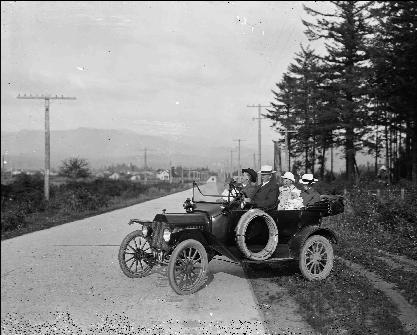
Resources
About
Contact
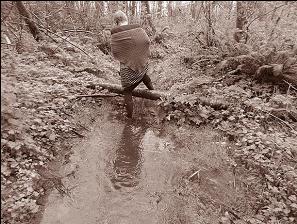
For thousands of years, the only way to get around present-day Enumclaw was by foot, supplemented a few hundred years ago by the small Cayuse ponies local tribes acquired from their counterparts east of the mountains. But the native topography of the Plateau and western slopes of the Cascades didn't lend itself well to trails any more than it did to roads much later. The Osceola mudflow left an immense flatland with little drainage and an almost impenetrable tangle of underbrush. Numerous river crossings and difficult terrain impeded travel once the trails entered the foothills and mountains.
Even so, predecessors to the Muckleshoots carved out routes along the White River, connecting winter villages with their man-made hunting and gathering prairies and leading over the Cascades. French-Canadian trappers and possibly Hudson's Bay Company spies used their trail across Naches Pass in the first half of the 19th Century, and Lt. Robert Johnson followed it on his exploratory journey in 1841 from Fort Steilacoom to Walla Walla. (1) The trail was adapted as a primitive wagon road in the 1850s by volunteers from the Puget Sound area and Yakima, and became the route of the 148 Longmire party immigrants in 1853. (2)
Alan Porter used the Indian trails to reach his Donation Land Claim in 1852, and for the next decades, travel between the tiny settlements on the Plateau was by roads hacked through the wilderness. Visiting your neighbors for a makeshift get-together involved some rather complicated preparations. Charles Coe remembered:
Even so, predecessors to the Muckleshoots carved out routes along the White River, connecting winter villages with their man-made hunting and gathering prairies and leading over the Cascades. French-Canadian trappers and possibly Hudson's Bay Company spies used their trail across Naches Pass in the first half of the 19th Century, and Lt. Robert Johnson followed it on his exploratory journey in 1841 from Fort Steilacoom to Walla Walla. (1) The trail was adapted as a primitive wagon road in the 1850s by volunteers from the Puget Sound area and Yakima, and became the route of the 148 Longmire party immigrants in 1853. (2)
Alan Porter used the Indian trails to reach his Donation Land Claim in 1852, and for the next decades, travel between the tiny settlements on the Plateau was by roads hacked through the wilderness. Visiting your neighbors for a makeshift get-together involved some rather complicated preparations. Charles Coe remembered:
"There were usually dances and parties to entertain the young people and it was not as easy to get to them as it is now. I recollect one time of a dance in what is now known as Wabash. Three of us went and it was so wet and so much water, that we wore our rubber boots and 'cooned' along side of roads on trees that had been cut and dragged off the road. Another time I went to a dance at Boise creek and had Aunt Mary Smith's pony for my lady to ride on while I walked alongside wearing rubber boots." (3)
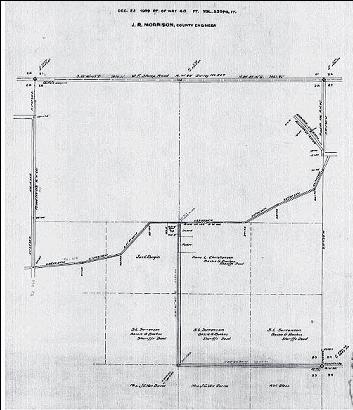
One of the first roads was opened along a portion of the Naches trail near Osceola. Known at times as Road No. 67 and L.C. Smith Road, it survives today as SE 456th Way west of Enumclaw. (4)
1901 survey of Road 67,following a portion of the old Naches Trail (456th Way today)
Transportation was essential for the survival of the pioneers, so they set about building their own roads with annual assessments and local labor. Ernest Kochevar told his interviewer: "Oh yes, they had a poll tax that you had to pay out, two dollars. So that's the way they worked it out on the road. But it was only two days, I remember it. . . . Peterson was the supervisor then and he'd send me all by myself clear up to Franklin for a load of gravel to fill in some holes." (5)
The first saloon, store, and hotel in Enumclaw opened onto Railroad Street, but it was so muddy with its standing water and beaver dams that Coal Street (later respelled) soon became the main street of town. That's where our tradition of parades began that continues to this day, although we stopped having horse races there.
Griffin was established as the main east-west street, connecting the two residential areas--the fashionable "hill" (Porter to Franklin) and the area south of the planing mill (around Garrett Street.) John Barnes and his oxen removed the huge old-growth cedar stumps from Griffin to eliminate the serpentine travel around them. (6)

Griffin and Cole. The hotel in the center is being moved down Griffin from the now empty corner lot (where Jackson's is today) to a lot across from where the current city hall is.
In town, walking around became somewhat easier with wooden sidewalks. At first, they were simply boards laid lengthwise. "It was just straight long planks laid out for sidewalks. We'd step on it on the one end of the plank and the mud would jump out on the other end if it was rainy." (7) But soon the walkways were laid out with boards perpendicular to the direction of foot travel.
Rufus Smith, son of J.J. Smith, recalled navigating the primitive streets. "There was civilization here although the streets were still muddy. I can remember how muddy those streets were. Wooden sidewalks and when you had to cross the street you know when the rains came real hard you were going to be up to your knees in mud. They used to haul sawdust and dump it in those areas, still you'd sink out of sight." (8)
Rufus Smith, son of J.J. Smith, recalled navigating the primitive streets. "There was civilization here although the streets were still muddy. I can remember how muddy those streets were. Wooden sidewalks and when you had to cross the street you know when the rains came real hard you were going to be up to your knees in mud. They used to haul sawdust and dump it in those areas, still you'd sink out of sight." (8)
Wood was also used in the early roads. Puncheons, logs flattened on one side and laid crosswise on the roadway, provided a stable base in the oozing mud for wagons and horses. In the Enumclaw Plateau Historical Society Museum, some of the original puncheons show marks from the special cleated horseshoes used for extra traction.
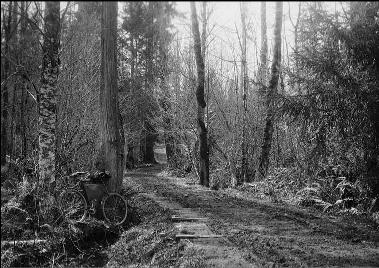
A puncheon road
outside Buckley
outside Buckley
Milt Allen told about his grandfather, John Barnes, hauling supplies from Meeker's Landing. "He would do much better in the summertime when he could carry a bigger load on the wagon. In the wintertime going through the Indian reservation, there was very little upkeep and they were puncheon roads and when they went through this two foot thick black soil here it was like slippery clay. The wagon wheels would cut down and they would cut through the grass that had grown in the summertime. Sometimes they could make two or three passes through this grass and the wheels wouldn't cut, however, when it would cut down about two inches the wheels would go way down and would come out with mud caked in them. They looked just like disc wheels." (10)
Gravel eventually covered some of the roads connecting the settlements, but this was arduous work, since it had to be hauled in wagons and spread by hand. The town finally purchased a Marion power shovel to assist with the increasing road work. Concrete paving began around 1915 for both major city and county roads.
"The root of the problem goes back thousands of years. The bridge was built on the edge of an ancient landslide and the entire southern edge of the Green River Gorge is shifting east and toward the river. The problem has been evident for years to SR 169 motorists who have noticed that the bridge deck and the highway are not exactly aligned - not be design, but rather due to the west-to-east movement of the entire hillside." (14)
Before that time, crossing the river meant using a cable and basket, a long plank, or various log arrangements long since gone. Near Franklin, a structure replaced a lower-level log bridge in 1915 and was upgraded in 1990. Traffic on this one- lane crossing is controlled today with a stoplight.

Before state highway renumbering in 1964, route 169 was known as the Enumclaw-Renton branch of Primary State Highway 5. It now leaves Enumclaw as Porter Street, a.k.a. 264th Avenue SE, and has crossed the 190-foot deep Green River Gorge on the Kummer Bridge since it was built in 1932. Unfortunately, available sites for a crossing were limited, so the south end of the arched steel bridge had to be constructed on an ancient landslide. In 2008, the shifting landslide threatened the bridge.
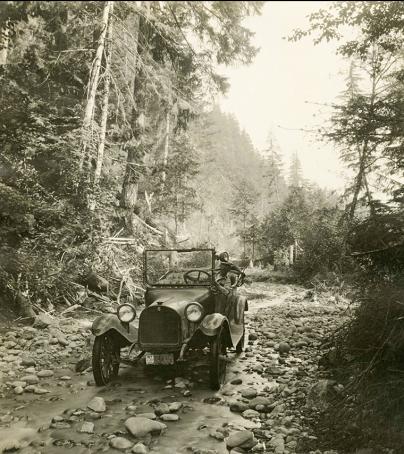

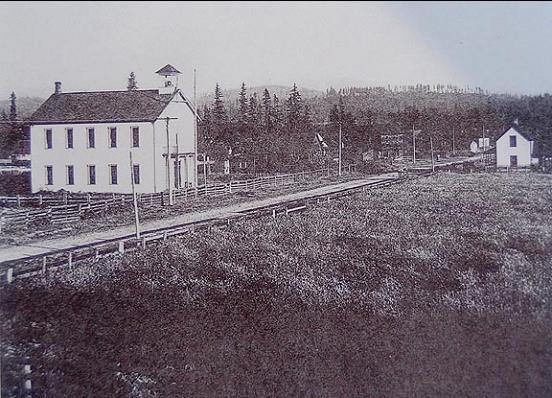

This is the road past the school in Boise, the largest of the early settlements. The school is located on what is now 244th Ave E, near its intersection with 464th St E.
An uncontrolled intersection

Today Enumclaw has two state roads terminating in town and one passing through. What is now SR 164 to Enumclaw from Auburn and 410 from there over the pass, was authorized by the legislature in 1897 as part of a state wagon road, making it one of the oldest highways in Washington. It followed the White River and crossed the Cascades, then the American River to Naches. It became known as State Route 1 in 1905 and the White River-Naches Road in 1907. In 1913, it was changed to State Route 5, to the McClellan Pass Highway in 1919, and to the Chinook Pass Highway in 1921. (11)
Early Chinook Pass Road
The highway from Buckley to Enumclaw formerly ran down Roosevelt (448th Street). When US 410 was first named, it ran from Aberdeen to Lewiston, Idaho. In 1973, its route was changed and shortened to its current configuration from Sumner to its intersection with highway 12 near Naches. (12) So our highway from here over the mountains has had many different names and starting points. Now part of it is called the Mather Memorial Parkway and the Chinook Scenic Byway, the latter extended to Farman Street in Enumclaw in 2013. (13)
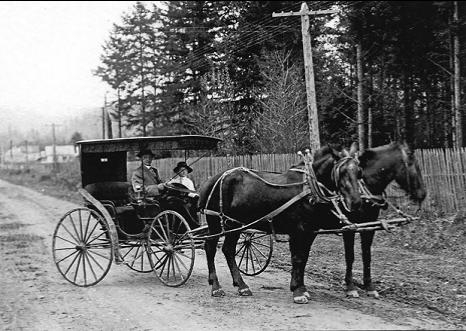
Roosevelt Avenue unpaved and paved
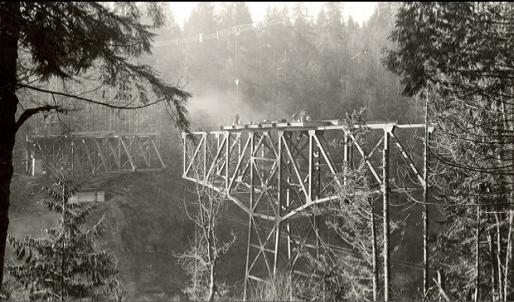

The Enumclaw-Auburn Highway was first paved in the early 1920s.
